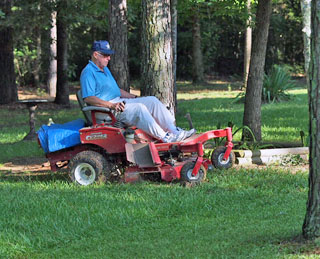Myth: Grass Cutting Height
Does Not Matter

The above title statement about grass cutting height is not true. Rather, repeated mowing below the minimum mowing height for your grass species can actually damage or kill your grass.
In fact, mowing too low is one of the most common mistakes people make. It is the grass' structure that determines how low it can be mowed. Some grass species cannot tolerate low mowing.
Read more to find out why.
Understanding Grass Form and Structure
It is important to understand how grass grows and what happens if it is cut too short. This is a real science, in case you are wondering. The science of grass form and structure is called "grass morphology".
The center of grass life takes place in the "Crown". The grass crown grows at ground level and is whitish in color. Grass blades extend upward from the crown and roots extend below ground. A person can remove the grass blades above the crown through mowing and can even cut some roots below and the crown will replace them. However, if the crown is cut, the grass may be slow to recover or can be permanently damaged. The crown height affects the mowing height of the grass.
Below are some important points concerning mowing height:
- What Determines Mowing Height: The correct mowing height is based on the structure of a grass species and not so much on personal preference. Each grass species has a minimum cutting height. Cutting below the minimum cutting height for your grass type will only weaken the grass and allow for weed invasion.
- Blade Length and Photosynthesis: It
is important that you mow your grass to maintain sufficient blade
length to continue photosynthesis. Photosynthesis takes part in the green blades. Photosynthesis is what produces the carbohydrates
required for plant life. In fact, carbohydrates, not fertilizer, is the food source all plant life. Fertilizer provides nutrients needed for plant function and the production of carbohydrates.
- Mowing Height and Root Depth: There is a direct link between blade length and root depth. The taller the grass blades are maintained, the deeper the roots go into the ground. If you routinely set your cutting height at a low setting, your grass roots will also be much shorter. Your grass cutting height is very important. There are exceptions, for example, centipede grass and others can suffer if maintained too high.
Determining Mowing Height
Cool Season Grasses: Tall Fecue, Kentucky Bluegrass, Perennial Ryegrass, Fine Fescue all have a minimum of 1.5 inches. However, they shouldn’t be maintained at that level. Standard grass cutting height is 3 inches. I personally maintain my fescue lawn at 3.5 inches year around. Taller cut grass can survive heat and dry periods much better than low cut grass. This is partly due to the connection between mowing height and root depth.
Warm Season Grasses: Warm season grass cutting height varies considerably by species. For example, St. Augustine should be cut at three inches or more, while some bermudagrass species can be maintained well below one inch. Remember, it is the grass variety that determines the correct height. Below are some general cutting heights for a few grass species.
- St. Augustine Grass- 2.5 to 3 inches
- Common Bermudagrass - 1 inch to over 2 inches
- Hybrid Bermudagrass – Depending on species .25 to 1 inch
- Zoysia – 1 to 2 inches
- Buffalograss – 2.5 to 3 inches
What About Golf Greens?
Golf course greens use a species of grass that can be maintained at extremely low cutting heights. In the southern states, Tifdwarf Bermudagrass is often used. Northern states and many southern states use creeping bentgrass. These grasses are designed to be maintained at extremely low heights.
Don't forget that golf greens are very high maintenance with many problems that requires experience to fix. In addition, greens are designed to accommodate these grass types. Home lawns are not built for such low cutting heights. You will scalp your lawn long before you get anywhere close to golf green height.
Grass Cutting Height Conclusion
While there are many different types of lawn grasses, the best lawn grasses will be among those that grow best in your climate zone. From there you can choose a variety that best fits your desires, including selecting one that fits your preferred look and mowing height.
Click on the link for more information about Grass Adaptation Zones.
Myth #1: The Myth of Soil Sterilization from Synthetic Fertilizers
The myth of soil sterilization from using synthetic fertilizers is
becoming one of the most often repeated misconceptions in lawn care.
Click here to learn more about this ever-growing myth.
Myth #2: Myth of Increasing Microorganisms in Soil By Adding More
Microorganisms are the backbone of soil life. To increase the
microbe populations we can simply add more via a commercial product or
homemade tea, right? Not Necessarily! Find the truth about soil microbes
and how they multiply.
Myth#3: Myth of Using Gypsum for Lawns to Raise Soil pH
Gypsum for lawns is often used as a liming material to sweeten the
soil. However, many people do not realize that it has no affect on soil
pH. Find out why and what important function gypsum has in the turf
industry.
Myth #5: The Truth and Misconceptions About Fertilizer Numbers
Understanding fertilizer numbers are for geeks and professionals,
right? Wrong. Knowing their meaning and how to use them properly is the
first step that separates the experienced from the inexperienced. Click
here to learn the truth and misconceptions about these numbers.
Grass Cutting Height back to Lawn Care Myths
Grass Cutting Height back to Lawn Care Academy Home
